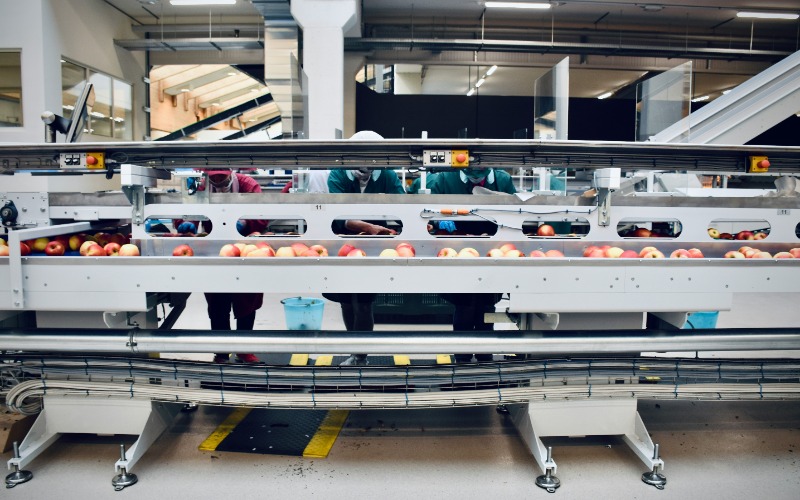Our eating habits have evolved significantly since the beginning of this century. Technology doesn’t often figure in discussions about food, but we’re seeing notable changes as more people turn to subscription boxes, delivery apps, and meal preparation services. The food industry is leveraging technological advancements to enhance production procedures in the supply chain and combat malnutrition caused by food scarcity. Discover the many ways technology is disrupting and transforming the food industry.
Demand for nutritious and safe food
Food production is growing rapidly, but this does not always guarantee customer safety. Manufacturers must focus on high quality. This is the reason for the increase in regulations in the food and beverage industry.
Recent EU food regulations and increasing demand for healthier, “clean” products are presenting food and beverage manufacturers with new challenges. How can they maintain the highest quality standards without compromising their brand image? The latest technological trends seem to offer the perfect solution.

 TrendingHow to succeed on Instagram: How to become an Instagram influencer
TrendingHow to succeed on Instagram: How to become an Instagram influencer
A recent ING report found that consumers expect healthier food options in stores in the future: 43% of respondents are looking for healthier options, while 18% are interested in environmentally friendly products, according to the report.
Packaging and waste
Consumers are increasingly prioritizing the consumption of healthy and sustainable products. They are keen to eliminate labels and harmful ingredients. In today’s age of intense social media scrutiny, it is becoming harder for companies to ignore such concerns. Many businesses are leveraging technology to adopt eco-friendly practices. Using robotics and digitalization, the food industry is actively seeking alternatives to harmful materials such as plastic for packaging.
The integration of technology in packaging ranges from innovative approaches like edible packaging, micro-packaging, packaging that inhibits bacterial growth, etc. Consumers are also taking a keen interest in companies’ sourcing practices and how they manage waste.
An astonishing 40% of America’s food supply is wasted each year. However, technological interventions are underway to minimize this waste and effectively reuse surplus food. Companies such as TDI Packsys offer inspection and automated packaging equipment solutions that help minimize food waste and ensure package integrity.
Recall
Traditionally, restaurants have focused their efforts primarily on making major changes to upgrade and update their back-of-house technology, which can include installing new computers and POS systems, investing in the latest tools to improve food quality, and any other necessary enhancements.
These changes directly affected customers, providing them with benefits like more accurate receipts, faster service, improved tasting food, etc. However, it’s worth noting that these changes and technology upgrades were not initially customer-centric.
Employees were the first to use and experience the benefits of the new technology, and the positive impact on customers was merely an incidental result, leaving many restaurants satisfied.
Data collection
Technological advances have completely transformed the way data is collected and utilized, allowing real-time tracking from farm to consumer. Data collection begins with tracking systems and soil testing. GPS-equipped drones monitor and detect pests that can cause damage or infection to crops. This technology empowers farmers to identify and address issues quickly, thus protecting more of their crops. With constant monitoring, farmers receive real-time data and can make necessary adjustments quickly.
By taking photos of crops as they grow, harvesting robots can pick only ripe produce. This data is recorded, allowing harvesters to determine when each item is ripe and ready to be harvested. Data collection is essential even beyond the initial production stage, and is also important for ensuring freshness during transport and reducing food waste.
Robots and Machines
In the food industry, robots and machines increase the speed and efficiency of production, reducing costs, labor, and worker injuries. Machine learning allows these machines to better manage land and water usage for different crops and farm conditions, which reduces the industry’s freshwater usage.
Food harvesting robots are becoming more and more popular because they can do the work of many workers, saving time and protecting workers from inclement weather like wildfires. Traditional forklifts are being replaced by automated guided vehicles that can load and unload trucks and move large items, often with fewer workers. These vehicles can also operate for long periods in extremely cold environments like cold storage rooms.
Reducing food waste
Every year, 1.3 billion tons of food is wasted, but the Internet of Things (IoT) can drastically reduce this number by continuously monitoring the condition and temperature of food and immediately notifying supervisors and managers of any abnormalities.
Built on the principles of IoT, “smart agriculture” helps farmers optimize efficiency and minimize food waste, using a variety of tools to this end, from advanced livestock tracking devices and agricultural sensors to intelligent greenhouses and agricultural drones.
footnote
Given the various technological advances, there are countless possibilities to dramatically change the way food is produced. The continued evolution of technology has the potential to address global hunger and tackle waste issues.


